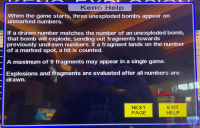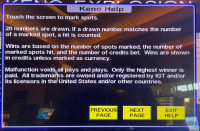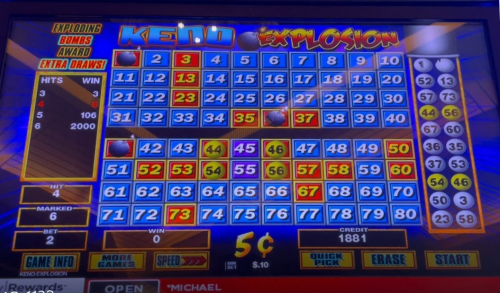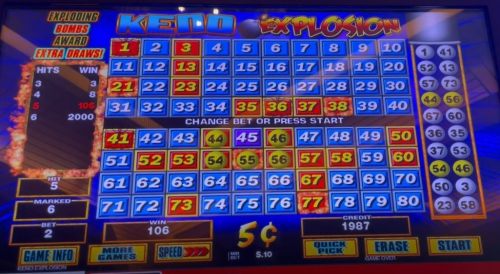On this page
Keno Explosion
Introduction
Keno Explosion is a unique variation of keno created by IGT. Players strategically place bombs on three numbers they do not select. If the drawn ball matches one of these bomb numbers, the bomb detonates, and any resultant fragments that land on the player’s selected numbers are counted as hits.
Rules
- Players can select between 2 and 10 numbers from a range of 1 to 80.
- In the game, three numbers that the player has not chosen will be randomly selected and designated with bombs.
- A total of 20 numbers will be drawn at random from the pool of 80, without any replacements.
- Should any of the numbers drawn correspond with a player’s selection, it counts as a 'catch.'
- If one of the three numbers marked with a bomb is drawn, that bomb will explode. After the detonation, one to three fragments may land on one of the 57 numbers that are neither selected by the player nor marked with a bomb.
- Each number can only be struck by a single fragment.
- If a bomb fragment lands on one of the player’s selected numbers, it is also regarded as a 'catch.'
- Based on a small sample size of 27 bombs, the average number of fragments generated per bomb is approximately 1.85.
- The player's winnings will depend on how many catches they achieve, as detailed in the published pay table.
- The pay table provided is simply an illustrative example from the Red Rock casino in Las Vegas based on a $0.10 wager.
If any of the rules seem confusing, you can find screenshots of the rule screens for clarification. Click on the images for a larger view.
 |
 |
The table below presents an example of a pay schedule. It's important to note that numerous payouts end in 0.5. To ensure that total payouts are rounded, players need to place bets using an even number of coins.
Keno Explosion Pay Table
| Catch | Pick 2 | Pick 3 | Pick 4 | Pick 5 | Pick 6 | Pick 7 | Pick 8 | Pick 9 | Pick 10 |
|---|---|---|---|---|---|---|---|---|---|
| 0 | 0 | 0 | 0 | 0 | 0 | 0 | 0 | 0 | 0 |
| 1 | 0 | 0 | 0 | 0 | 0 | 0 | 0 | 0 | 0 |
| 2 | 12 | 2 | 1 | 0 | 0 | 0 | 0 | 0 | 0 |
| 3 | 32.5 | 3.5 | 2 | 1.5 | 0.5 | 0 | 0 | 0 | |
| 4 | 107 | 12.5 | 4 | 1.5 | 1 | 0.5 | 0 | ||
| 5 | 450 | 53 | 13 | 7 | 3 | 2.5 | |||
| 6 | 1000 | 217 | 54 | 23 | 12 | ||||
| 7 | 3750 | 835 | 171 | 77 | |||||
| 8 | 5000 | 2400 | 505 | ||||||
| 9 | 5000 | 2300 | |||||||
| 10 | 5000 |
Example
In the illustration below, I selected six numbers: 44, 45, 46, 54, 55, and 56. The bombs were activated on 1, 36, and 41. This image was captured following the ball draw but prior to the bomb detonations. It’s notable that I successfully caught four of my six chosen numbers, which led to a winning payoff of 8.
The image above was taken subsequent to the explosion of the bombs. Fragments landed on the numbers 21, 38, 55, and 77, which are highlighted in red and appear to be ignited. The bomb-marked numbers 1, 36, and 41 show evidence of damage. A fragment impacted 55, a number I picked, raising my catches from 4 to 5 and substantially increasing my winnings from 8 to 106.
Are Bombs Gaffed to Explode?
The following table illustrates the statistical likelihood of capturing between 0 to 3 bombs during the game’s 20-ball draw, taking into account standard probabilities where each bomb has a 25% chance of matching a drawn ball, calculated as 20 out of 80. Note that the odds of all three bombs being matched is 0.013875.
Expected Bomb Explosions
| Bomb Catches |
Combinations | Probability |
|---|---|---|
| 3 | 1140 | 0.013875 |
| 2 | 11400 | 0.138754 |
| 1 | 35400 | 0.430867 |
| 0 | 34220 | 0.416504 |
| Total | 82160 | 1.000000 |
The upcoming table reveals how many bombs were successfully hit based on the outcomes from a small sample of 208 games. The rightmost column indicates the anticipated number of games that would yield various counts of bomb catches.
Bomb Catches Sampling
| Bomb Catches |
Sample Observations |
Expected |
|---|---|---|
| 3 | 30 | 2.89 |
| 2 | 34 | 28.86 |
| 1 | 25 | 89.62 |
| 0 | 119 | 86.63 |
| Total | 208 | 208.00 |
In the 208 games analyzed, there were 30 instances where all three bombs detonated. If the game operated under typical odds, we would expect approximately 2.89 instances of all bombs exploding.
The likelihood of 30 or more bombs detonating in the 208-game sample is astonishingly 17.78 standard deviations from what one would normally expect. The chance of seeing 30 or more occurrences is roughly 1 in 20,840,430,698,432,300,000,000,000,000,000,000,000,000,000,000,000,000,000,000,000.
Conducting a chi-squared test on the gathered observations compared to the expected outcomes results in an extreme probability of 1 in 12,703,492,578,520,200,000,000,000,000,000,000,000,000,000,000,000,000,000,000,000.
It's essential to point out that the first rule screen states, 'Explosions and fragments are assessed after all numbers are drawn.' While this wording could be interpreted in various ways, it suggests that the outcomes related to the bombs are likely determined independently of the ball draws.
I want to stress that if this game has been manipulated, it appears to be skewed in a way that benefits players. Nonetheless, I believe that any form of manipulation, in either direction, breaches regulations that specify, 'For gaming devices representative of live gambling games, the mathematical probability of any symbol or element appearing in a game outcome must align with the actual probabilities found in real-life gambling scenarios.' Nevada Revised Statute 14.040.5 A simulated version of this game, which assumed typical odds across its mechanics, indicated a return rate of 82.49%. As far as I am aware, the developers, IGT, only permit return rates of at least 85%. Comparatively, other 5-cent keno games available on the same machine at Red Rock averaged a return rate of 89.45%. This serves as further evidence that the game has been adjusted so that the drawn balls are more likely to trigger bomb activations compared to a naturally conducted game, where every number has equal drawing odds.
In this video, I present my findings and rationale to highlight how Keno Explosion deviates from the standard probabilities associated with live keno games.
Video
Learn to apply mathematically sound strategies and insights for various casino games like blackjack, craps, roulette, and many more.





